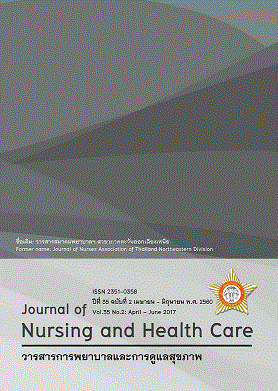ปัจจัยทำนายพฤติกรรมการป้องกันโรคมือเท้าปากของผู้ดูแลเด็กในศูนย์พัฒนาเด็กเล็ก Predictors of Preventive Behaviors for Hand Foot Mouth Disease among Caregivers in Childcare Center
คำสำคัญ:
โรคมือ เท้า ปาก พฤติกรรมการป้องกัน ปัจจัยทำนาย hand foot mouth disease, preventing behaviors, predictorsบทคัดย่อ
บทคัดย่อ
การศึกษาครั้งนี้เป็นการวิจัยเชิงพรรณนาเพื่อทำนายพฤติกรรมการป้องกันโรคมือเท้าปากของผู้ดูแลในศูนย์ดูแลเด็กเล็ก จำนวน 200 คน เลือกกลุ่มตัวอย่างโดยวิธีแบ่งสัดส่วน ศึกษาในช่วงเดือนพฤศจิกายน ถึง ธันวาคม 2557 เครื่องมือประกอบด้วย แบบประเมินพฤติกรรมป้องกันโรคมือเท้าปากของผู้ดูแลเด็ก แบบสอบถามการรับรู้ประโยชน์ แบบสอบถามการรับรู้อุปสรรค แบบสอบถามการรับรู้สมรรถนะแห่งตน และแบบสอบถามการสนับสนุนทางสังคมในการปฏิบัติพฤติกรรมป้องกันโรคมือ เท้า ปาก วิเคราะห์ข้อมูลโดยหาค่าสถิติ ร้อยละ ค่าเฉลี่ย และส่วนเบี่ยงเบนมาตรฐาน และ วิเคราะห์ถดถอยพหุคูณแบบขั้นตอน
ผลการวิจัยพบว่า การสนับสนุนทางสังคมของหน่วยงานที่ศูนย์เด็กเล็กสังกัด และการรับรู้สมรรถนะแห่งตน สามารถร่วมกันทำนายพฤติกรรมป้องกันโรคมือ เท้า ปาก ร้อยละ 9.3 มีระดับนัยสำคัญทางสถิติที่ระดับ P<0.05 โดยการสนับสนุนทางสังคมของหน่วยงานที่ศูนย์เด็กเล็กสังกัดสามารถทำนายพฤติกรรมป้องกันได้สูงสุด สรุปได้ว่า การป้องกันโรคมือเท้าปากเกิดประสิทธิภาพมากขึ้นหน่วยงานต้นสังกัดของศูนย์พัฒนาเด็กเล็กควรวางแผนจัดทำกิจกรรมเพื่อส่งเสริมสมรรถนะผู้ดูแลเด็กให้มีความเชื่อมั่นในความสามารถของตนที่จะปฏิบัติพฤติกรรมป้องกันการติดเชื้อโรคมือ เท้า ปาก มากยิ่งขึ้น
Abstract
This descriptive study aimed to examine factors predicting preventive behaviors for hand foot mouth disease among 200 caregivers in childcare center. Participants were selected using proportional sampling. The study was conducted from November to December 2014. Data were collected using the questionnaires including items on preventive behaviors for hand foot mouth disease, perceived benefit, perceived barrier, perceived self-efficacy, and social support. Data were analyzed by using percentage, mean, standard deviation and stepwise multiple regression.
Results revealed that organization support (social support) combined with perceived self-efficacy significantly predicted the preventive behaviors for hand foot mouth disease at 9.3% (p<.05) among the caregivers. The best predictor of the preventive behaviors for hand foot mouth disease was organization support. In conclusion, to promote preventive behaviors for hand foot mouth disease among caregivers in childcare center, organization policy to support preventive behaviors and encourage self-efficacy associated with preventive behaviors is recommended.



